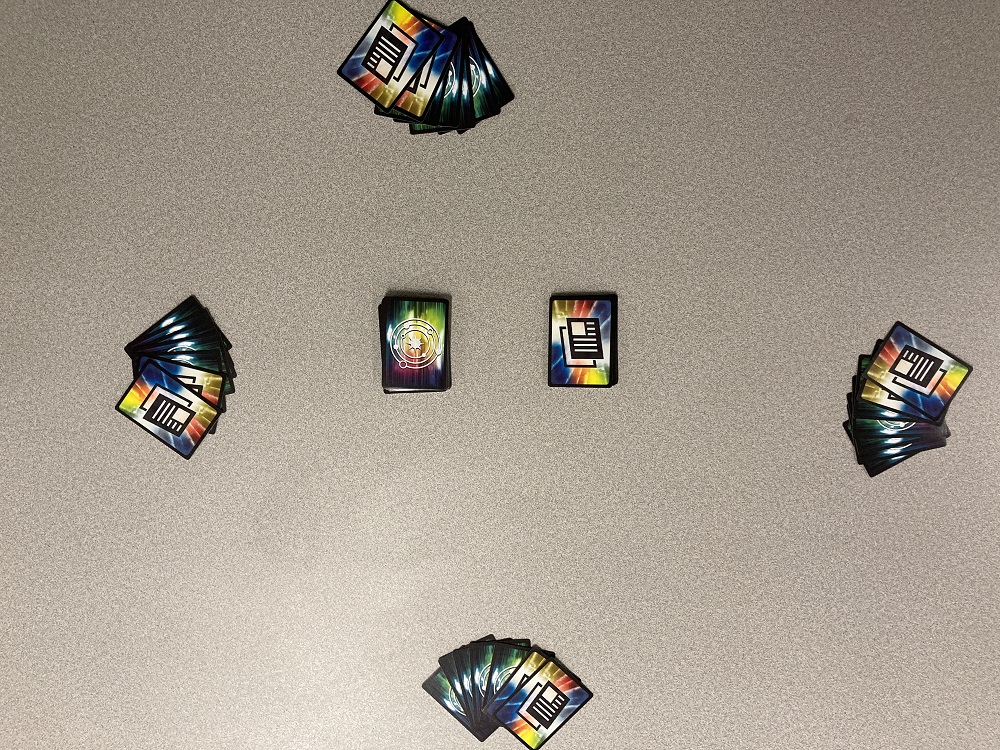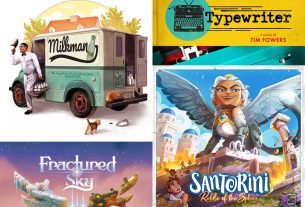In 2017, a new card game hit the scene. Fantasy Realms featured colorful cards with a variety of suits based on fantasy-themed characters, creatures, locations, items, etc. Players use a draw and discard mechanic to create combinations to score the most points at the end of the game. Many cards received bonuses from having specific cards in a player’s hand. However, cards also had penalties that could reduce or wipe out points on other cards. An expansion, The Cursed Hoard, was released in 2021 and added new three suits and cursed items that provided players with special abilities, but at a cost. Now, in 2022, a new game based on the mechanics of Fantasy Realms has beamed down to Earth to allow players to explore the final frontier of space in Star Trek: Missions.
What Is Star Trek: Missions?
Star Trek: Missions is a combo-building card game set in the Star Trek universe for 2-6 players, ages 14 and up, and takes about 20 minutes to play. Players draw cards with characters, equipment, locations, artifacts, and systems on the Enterprise and attempt to complete missions to score points at the end of the game. Star Trek: Missions is based on the Fantasy Realms card game, which is not only GeekDad Approved but was also a finalist for the 2021 GeekDad Game of the Year. The game is currently available from your FLGS as well as Amazon for a suggested retail price of $19.99 for a copy of the game. Star Trek: Missions was designed by Bruce Glassco and published by WizKids, with graphic design by Daniel Solis, Renee Lasater, and Richard Dadisman.
Star Trek: Missions Components
Here is what you get inside the box:
- 50 Galaxy Cards
- 24 Mission Cards
- 1 Score Pad
- 1 Rule Book

Galaxy cards are the main cards in the game used to score points. Each card has five pieces of information. Type designates the class of a card and includes characters, equipment, systems, and so forth. Some types can have one or more specialties such as command, combat, science, medical, etc. There are several types of lifeforms in the Star Trek universe such as Human, Vulcan, Klingon, and more. Some cards may have an affiliation which is a faction with which they align such as the Federation and the Klingon Empire. Finally every card has text which describes a bonus the card receives when it is in the same hand with certain other cards.

Mission cards work similarly to Galaxy cards but only have text for bonuses. The don’t have the the other kinds of information. You must always have one or two Mission cards in your hand.

The score pad is used at the end of the game to calculate the score of each card in your hand based on the bonuses. Then you can add the values of each card to determine your total score.
How to Play Star Trek: Missions
The Goal
The goal of the game is to assemble the highest-scoring combos possible by drawing cards from the Galaxy deck, the Mission deck, or the discard area.
Setup
Start off by shuffling the Galaxy and Mission decks separately. Then deal five Galaxy cards and two Mission cards to each player. Place the two decks face down in the middle of the play area and leave room for nearby for the discard area. Choose a player to start and and then continue play clockwise.

Gameplay
During each player’s turn, they must choose one of three options:
- Take a card from the discard pile, then discard a different card to the discard pile.
- Draw the top card from the Galaxy deck, then discard any card to the discard area.
- Draw two cards from the top of the Mission deck, then discard any two cards to the discard area.
All of the cards in the discard area should be faceup and spread out so they are visible to all players. Also, at the end of a player’s turn, they must have 1 or 2 Mission cards in their hand. Players may never have zero or more than two.
Game End
The game ends when there are either 8 Galaxy cards or 12 Mission cards in the discard area. Then players score their hands. The player with the highest hand is the winner. In case of a tie, the tied players share the victory.
Scoring
When the game ends, each card in a player’ hand scores points based on the other cards in their hand. Cards do not have a base value themselves. A Galaxy card can only give one bonus to another card even if it meets more than one criteria for a bonus. When scoring, place your hand faceup in front of you in a line and then score each card individually and write the score on the score pad. After each card has been scored, then add up the scores to calculate the total score.

Let’s take a look at an example of scoring using the cards in the above image.
- Captain Jean-Luc Picard scores only 3 for the Quarters location.
- Spock scores 0
- Lwaxana Troy scores 18 for having both Captain Jean-Luc Picard and Counselor Deanna Troi
- Counselor Deanna Troi scores 15 since there are 3 different lifeforms not counting herself.
- Quarters scores 12 since there are at least 2 Federation personnel, civilians, or captains
- Language Barrier scores 24 for one Vulcan and two Betazoids.
- Blossoming Romance scores 26 (8 for Captain Jean-Luc Picard and Spock, plus 6 each for Lwaxana Troy, Counselor Deanna Troi, and Quarters). Counselor Deanna Troi can only provide 6 points even though she is both a Counselor and a Betazoid because each card can only provide one bonus on another card.
The total for this hand is 98. Note that even though Captain Jean-Luc Picard and Spock score little or no points, they help add to the points scored by other cards.
Why You Should Play Star Trek: Missions
Fantasy Realms is one of my favorite games. Therefore, when I learned that a new game based on its mechanics was coming out, and it incorporated a Star Trek theme, I could not wait to get my hands on it. I am not disappointed. I like the addition of the mission cards. They really work well with the theme and provide some guidance for creating a hand. In fact, it feels like you are assembling an episode of Star Trek: The Next Generation. This also makes the game a bit easier for new players to learn. Unlike Fantasy Realms, the cards in Star Trek: Missions have no base value. This makes scoring a bit easier since you only look at the bonus requirements to get the score for each card. Both of these features help make Star Trek: Missions a bit more approachable for newer players.
I really enjoy playing Star Trek: Missions. It is very easy to teach to new players and the game play is simple: draw and then discard. The discard area acts as a timer. Drawing from the decks essentially advances the ‘timer’ while taking a card from the discard area keeps the the ‘timer’ from progressing. As a result, players need to keep track of how many cards are in the discard area and adjust their strategy accordingly. If it looks like the game is about to end, you may want to switch to other mission cards that may not score as much rather than trying to get the right combos for a higher score that may not come to pass. This keeps all players engaged as they watch what cards are discarded during each turn and scoring strategies can change on the fly. Since a game usually only lasts about 20 minutes, you can play several games for an evening. You can also use it as a starter for a game night while waiting for everyone to arrive or just to get everyone warmed up for a meatier game. Star Trek: Missions is a great game to take with you while travelling or camping. Due to its short playtime, it’s perfect to play during a break or lunch at work. All you need is space for the decks and the discards. Star Trek: Missions has fun and engaging gameplay, a great theme that fits the mechanics rather than just being an overlay, and provides for quick games in a variety of settings. For these reasons, I highly recommend Star Trek: Missions as a great addition to your game collection whether you are a Trekkie or not.
For more information, visit the Star Trek: Missions page!
Click here to see all our tabletop game reviews.
![]() To subscribe to GeekDad’s tabletop gaming coverage, please copy this link and add it to your RSS reader.
To subscribe to GeekDad’s tabletop gaming coverage, please copy this link and add it to your RSS reader.
Disclosure: GeekDad received a copy of this game for review purposes.





